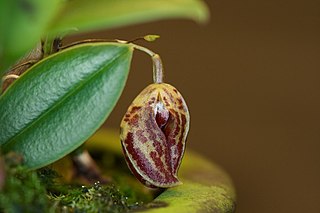
Pleurothallis is a genus of orchids commonly called bonnet orchids. The genus name is derived from the Greek word pleurothallos, meaning "riblike branches". This refers to the rib-like stems of many species. The genus is often abbreviated as "Pths" in horticultural trade.

The Pleurothallidinae are a neotropical subtribe of plants of the orchid family (Orchidaceae) including 29 genera in more than 4000 species.

In the botanical classification of plants, Aeridinae Pfitzer is a subtribe of the tribe Vandeae whose representatives all have a monopodial growth habit and do not possess pseudobulbs.

Cymbidium, commonly known as boat orchids, is a genus of evergreen flowering plants in the orchid family Orchidaceae. Orchids in this genus are epiphytic, lithophytic, terrestrial or rarely leafless saprophytic herbs usually with pseudobulbs. There are usually between three and twelve leaves arranged in two ranks on each pseudobulb or shoot and lasting for several years. From one to a large number of flowers are arranged on an unbranched flowering stem arising from the base of the pseudobulb. The sepals and petals are all free from and similar to each other. The labellum is significantly different from the other petals and the sepals and has three lobes. There are about fifty-five species and sixteen further natural hybrids occurring in the wild from tropical and subtropical Asia to Australia. Cymbidiums are well known in horticulture and many cultivars have been developed.

Selenicereus, sometimes known as moonlight cactus, is a genus of epiphytic, lithophytic, and terrestrial cacti, found in Mexico, Central America, the Caribbean and northern South America. The term night-blooming cereus is also sometimes used, but this is also used for many night-blooming cacti, including Epiphyllum and Peniocereus. In 2017, the genus Hylocereus was brought into synonymy with Selenicereus. A number of species of Selenicereus produce fruit that is eaten. The fruit, known as pitaya or pitahaya in Spanish or as dragon fruit, may be collected from the wild or the plants may be cultivated.

Myoxanthus is a genus of orchids with about 50 species, widely distributed in Central and South America. This genus is a close ally of Pleurothallis.
Andreettaea is a genus of flowering plant in the family Orchidaceae, native to southern Mexico, the West Indies and tropical South America. The genus was established in 1978. Some sources treat the genus as a synonym of Pleurothallis.

Phloeophila is a genus of orchids belonging to the tribe Pleurothallidinae. While an initial molecular phylogeny in 2013 suggested that the type species of the genus was nested within Pabstiella, further sampling showed that it in fact belongs to a unique clade distant from Pabstiella, forming the current basis of the genus.

Trichosalpinx, commonly known as the bonnet orchid, is a genus of about 100 species of neotropical orchid. The genus is widespread across most of Latin America from northern Mexico to Bolivia, as well as the West Indies.

The genus Arachnis, abbreviated as Arach in horticultural trade, is a member of the orchid family (Orchidaceae), consisting of more than 20 species native to China, India, Southeast Asia, Indonesia, the Philippines, New Guinea, and the Solomon Islands.

x Senecurio kleiniiformis is a hybrid species of flowering plant in family Asteraceae. It has been placed in either the genus Senecio, as Senecio × kleiniiformis, or Kleinia, but is now thought to be a hybrid between an unknown species of Curio and Senecio tropaeolifolius. It was initially named Curio × kleiniiformis, but in 2020 the hybrid genus Senecurio was created for it.

Cymboglossum, synonym Ascidieria, is a genus of flowering plants from the orchid family, Orchidaceae. It is native to Borneo, the Philippines, Sulawesi and Sumatra.

Hymenorchis is a genus of flowering plants of the orchid family, Orchidaceae. It is native to Vietnam, Malaysia, Indonesia, Philippines, New Guinea and New Caledonia.

Microsaccus is a genus of flowering plants from the orchid family, Orchidaceae. It is native to Southeast Asia.

Pteroceras is a genus of flowering plants from the orchid family, Orchidaceae. It is native to China, the Indian Subcontinent, and Southeast Asia.
Ophidion is a genus of flowering plant in the family Orchidaceae, native to Panama to western South America and Venezuela. The genus was established by Carlyle A. Luer. It has been included in a broad circumscription of Phloeophila, but there is evidence that it forms a monophyletic taxon, and it is accepted by Plants of the World Online.
Acianthera cachensis is a species of orchid native to Costa Rica. It was first formally named Pleurothallis cachensis in 1923 and transferred to the genus Acianthera in 2016.

Kimnachia is a monotypic genus of cacti. Its only species is Kimnachia ramulosa, synonym Pseudorhipsalis ramulosa, which is native from southern Mexico to northern South America and also found in Jamaica.
Stelis rodrigoi is a species of flowering plant in the family Orchidaceae, native to Colombia. It was first described by Carlyle A. Luer in 1982 as Condylago rodrigoi.
Stelis furculifera is a species of flowering plant in the family Orchidaceae, native to Panama. It was first described in 2007 as Condylago furculifera.













